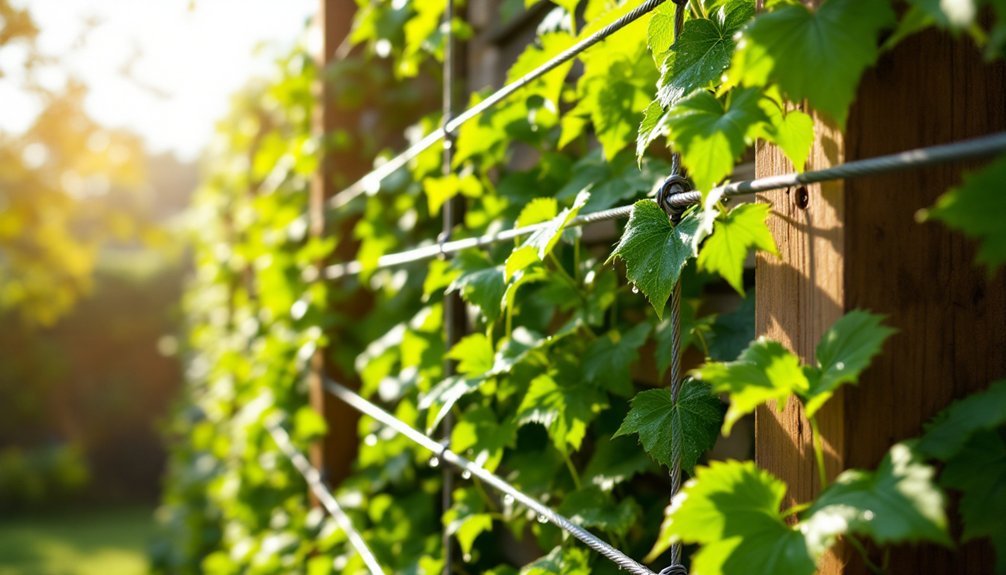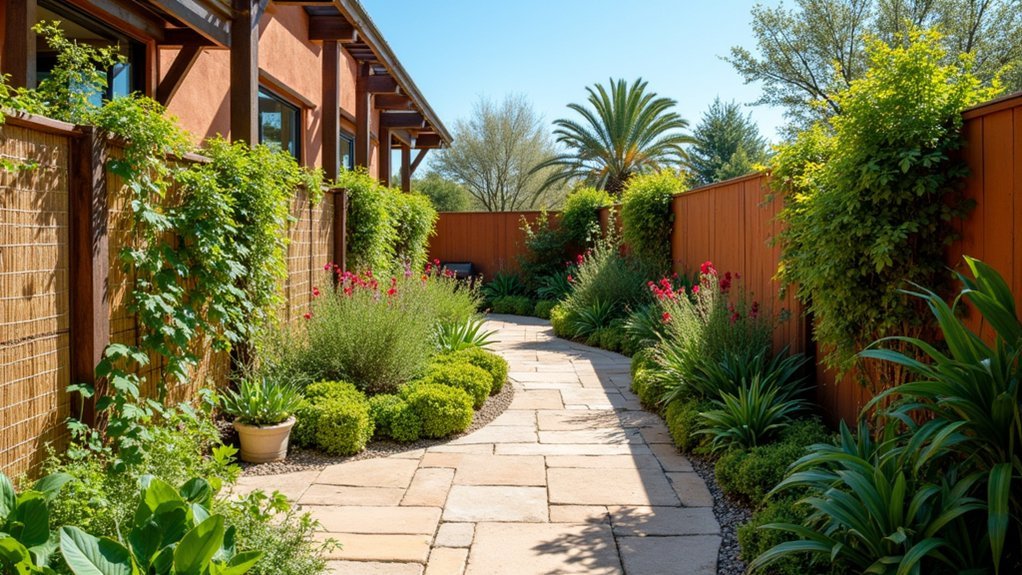You've likely noticed how stunning living fences can transform an ordinary garden into a natural sanctuary. But without proper support, even the most beautiful climbing plants will falter and sag. That's where stainless steel wire comes in—offering both structural integrity and sleek aesthetics that won't detract from your greenery. The right wire can mean the difference between a thriving vertical garden and a disappointing tangle. Let's explore the top options that balance strength, longevity, and design.
Stainless Steel Hardware Cloth 1/2 inch Welded Wire Mesh for Fencing
Gardeners battling persistent critters will find the 304 stainless steel hardware cloth a superior alternative to standard galvanized options. This 21-gauge mesh with 1/2-inch openings combines durability with practicality, measuring 16 inches wide by 8 feet long.
You'll appreciate its rust-proof, acid and alkaline-resistant properties that guarantee longevity in various environments. The flexible design makes installation straightforward—just cut to size and secure with the included binding wire (20 pieces at 11.8 inches each). It's perfect for protecting vegetable gardens from voles and gophers while supporting living fences.
Best For: Serious gardeners, poultry keepers, and homeowners fighting persistent small critters like voles, gophers, and raccoons who need a long-lasting, rust-resistant barrier.
Pros:
- Superior 304 stainless steel construction offers significantly longer lifespan than standard galvanized mesh, withstanding harsh weather and corrosive environments
- Versatile 1/2-inch openings with 21-gauge thickness provide excellent protection against small pests while being strong enough for various applications
- Comes with 20 pieces of binding wire included, making installation easier and more convenient right out of the box
Cons:
- Premium price point compared to traditional galvanized hardware cloth options
- Limited width of 16 inches may require multiple strips for larger coverage areas
- Sharp edges after cutting can pose safety hazards, requiring careful handling and gloves during installation
apbgwj Stainless Steel Welded Wire Mesh, 304 Hardware Cloth
Those seeking a versatile and long-lasting support solution for living fences will find the apbgwj 304 Stainless Steel Welded Wire Mesh an excellent choice. This 19-gauge hardware cloth offers impressive durability with its precision-welded construction that resists deformation while providing strong tensile strength.
You'll appreciate its anti-corrosion properties that maintain appearance even in harsh weather conditions. At 15.7 inches by 24 feet, it's easily customizable for projects of any size. The 1/2-inch openings create ideal support for climbing plants while keeping pests at bay. With high customer ratings and multi-purpose applications, this Chinese-manufactured mesh delivers reliable performance for both decorative living fences and practical garden solutions.
Best For: Gardeners and DIY enthusiasts seeking a durable, corrosion-resistant wire mesh for creating living plant supports, garden protection, or small animal enclosures.
Pros:
- Made from high-quality 304 stainless steel that resists rust and corrosion even in harsh weather conditions
- Versatile 1/2-inch grid pattern and customizable size (15.7in × 24ft) makes it suitable for various garden and home applications
- Strong 19-gauge construction provides excellent tensile strength while remaining flexible enough to cut and shape as needed
Cons:
- At 4 pounds, it may be heavier and more difficult to handle than lighter alternatives
- Some customers noted the mesh might be thinner than expected compared to other options on the market
- Price point may be higher than non-stainless steel alternatives with similar dimensions
Insaga Stainless Steel Fence Staples for Softwood & Wire Fencing
When supporting a living fence with long-term durability in mind, Insaga's Stainless Steel Fence Staples offer an excellent solution that eliminates common installation headaches. These 304 stainless steel fasteners resist rust and corrosion while providing superior holding power with their two-teeth design.
You'll appreciate how easily these staples install with a cordless drill—no pre-drilling or hammered fingers. The package includes 50 reusable fasteners plus a hex adapter, making them perfect for attaching chicken wire, hardware cloth, or chain link to your living fence framework. They're particularly effective with softwood supports and mesh fencing. Just avoid over-tightening to prevent snapping.
Best For: Homeowners and DIY enthusiasts looking for durable, reusable fence staples that make attaching wire fencing to softwood easier and safer than traditional hammered staples.
Pros:
- Made of anti-rust, anti-corrosion 304 stainless steel for long-term outdoor durability
- Installs quickly with a cordless drill, eliminating the need for hammering and reducing injury risk
- Two-teeth design on each side provides superior holding power to prevent pull-out from softwood
Cons:
- Can snap if over-tightened during installation
- Limited to 50 staples per package, which may not be sufficient for larger fencing projects
- May be more expensive than traditional hammered fence staples
Fi-Shock WC-14200 200-Feet, 14 Gauge Spool Galvanized Steel Wire
Serious living fence enthusiasts will appreciate the Fi-Shock WC-14200's impressive 698-pound breaking load and 150,000 PSI tensile strength. This 14-gauge galvanized wire excels at supporting heavy vines like grapes and blackberries without sagging.
You'll find this 200-foot spool versatile enough for trellises, fencing, and reinforcing chicken coops. Its rust-resistant coating guarantees year-round durability against harsh weather.
Be cautious when handling—you'll need proper wire cutters and pliers for installation. While the wire performs excellently, the plastic spool can be brittle. The wire's malleability allows for customization while maintaining structural integrity for your living fence projects.
Best For: Gardeners and small-scale farmers looking for a strong, durable wire solution for trellises, living fences, and reinforcing existing enclosures.
Pros:
- Exceptional strength with 698-pound breaking load and 150,000 PSI tensile strength
- Rust-resistant galvanized coating ensures long-term outdoor durability in various weather conditions
- Versatile 200-foot length suitable for multiple applications from supporting heavy vines to reinforcing chicken coops
Cons:
- Plastic spool is brittle and prone to breaking during shipping or handling
- Requires proper tools (wire cutters and pliers) for safe and effective installation
- Sharp wire ends can pose safety hazards if not handled carefully during unwinding and cutting
100 Pcs Stainless Steel Fence Wire Clamps with Screws
Gardeners and homeowners creating living fences will find 304 stainless steel fence wire clamps invaluable for constructing reliable support systems. These R-type clamps attach 12-16 gauge welded wire fencing to various post materials, from wood to vinyl to metal.
You'll appreciate how these clamps distribute pressure evenly when placed every 2-3 feet along your fence line. Their rust-resistant properties guarantee your living fence support remains intact through seasons of weather exposure.
While most users report excellent durability, install them properly to avoid bending issues under heavy loads. They're versatile enough for multiple applications beyond fencing, including cable management in various settings.
Best For: Homeowners and gardeners seeking durable, weather-resistant fasteners to secure wire fencing to various post materials for creating reliable enclosures or plant support systems.
Pros:
- Made from 304 stainless steel that offers superior rust and oxidation resistance for long-lasting outdoor performance
- Versatile application across multiple post materials including vinyl, wood, PVC, steel, and composite
- Comes with 100 pieces and matching screws, providing complete installation supplies for medium to large fencing projects
Cons:
- Some users report issues with bending or tearing under heavy loads, suggesting potential quality inconsistencies
- Limited to 12-16 gauge wire fencing applications, making them unsuitable for heavier gauge requirements
- Requires proper spacing every 2-3 feet for optimal pressure distribution, which may increase installation time and labor
Factors to Consider When Choosing the Most Versatile Stainless Steel Wire for Living Fence Support
When selecting stainless steel wire for your living fence, you'll need to balance the appropriate wire gauge with your specific tensile strength requirements. Your wire must withstand various weather conditions while remaining manageable during installation without specialized tools. Consider how the wire will attach to your fence posts, as different attachment methods can markedly impact both the initial setup and long-term maintenance of your living fence system.
Wire Gauge Considerations
Understanding wire gauge numbers is essential for creating effective living fence supports. Remember that lower gauge numbers indicate thicker wires—a 14-gauge wire is substantially thicker than a 21-gauge option.
For your living fence, gauge selection should match your specific needs. If you're supporting heavy climbing plants or creating a structure that will bear significant weight, opt for thicker 14-gauge wire that offers superior tensile strength and durability. This heavier option will withstand harsh weather conditions and maintain integrity over time.
If you're working with delicate plants or creating lightweight trellising, a thinner 19 or 21-gauge wire may be preferable. These lighter options provide greater flexibility and are easier to manipulate during installation, though they won't support as much weight as their thicker counterparts.
Weather Resistance Properties
Since your living fence will face the full force of nature year-round, selecting wire with superior weather resistance becomes crucial for long-term success. Stainless steel wire stands out as an exceptional choice, particularly the 304 grade, which offers outstanding rust-proof and corrosion-resistant properties.
Unlike conventional galvanized alternatives, high-quality stainless steel maintains its structural integrity even when exposed to rain, wind, and temperature extremes. You'll appreciate its anti-oxidation qualities that prevent deterioration in humid or saline environments where other materials quickly fail.
The wire's ability to withstand high temperatures without degrading guarantees your living fence support remains stable through scorching summers and freezing winters. This resilience translates to fewer replacements and repairs, making stainless steel the smart investment for durable, weather-resistant fence supports that complement your living plants.
Tensile Strength Requirements
The tensile strength of your stainless steel wire directly impacts how effectively it will support your living fence as plants grow and mature. When selecting wire, remember that gauge numbers work inversely to strength—lower gauge numbers indicate thicker wire with higher tensile strength.
For robust support, consider 14-gauge stainless steel wire with approximately 150,000 PSI tensile strength, capable of supporting loads up to 698 pounds. This provides ample capacity for mature vines and climbing plants while withstanding environmental stresses.
Don't overlook corrosion resistance, as rust can greatly compromise tensile integrity over time. Match your wire's strength to your specific application—heavier climbing plants like wisteria or grape vines require stronger support than lightweight clematis or jasmine. Properly sized wire guarantees your living fence remains structurally sound throughout its lifespan.
Installation Difficulty Level
Installation difficulty represents a practical consideration that can make or break your living fence project, even with the strongest wire available. When selecting stainless steel wire, pay attention to gauge thickness—thinner wires (higher gauge numbers) are typically easier to manipulate but offer less strength than their thicker counterparts.
Look for products with installation-friendly design features like pre-drilled holes or specialized fastening systems that simplify securing the wire to posts. The wire's flexibility also matters greatly; more pliable materials allow easier cutting and shaping around irregular spaces or curves in your living fence design.
Consider what tools you'll need—some premium wires require specific equipment that you might not already own. Before purchasing, check user reviews that often highlight real-world installation challenges, helping you avoid products with commonly reported difficulties.
Post Attachment Methods
Securing your stainless steel wire to fence posts effectively determines the long-term stability and resilience of your living fence system. For ideal attachment, you'll want to use 304 stainless steel R-type clamps that evenly distribute pressure across your fence while resisting rust and oxidation in outdoor environments.
Position your fasteners every 2-3 feet both horizontally and vertically to maintain proper tension throughout the fence structure. This systematic spacing prevents sagging and guarantees uniform support for your living plants.
Consider using specialty screws designed specifically for wire fencing to prevent loosening over time. Alternatively, reusable fence staples installed with a cordless drill can greatly reduce your installation time while providing secure attachment points. These quick-install options offer both convenience and reliability for long-term fence maintenance.
Aesthetic Design Options
When planning your living fence's visual elements, consider how stainless steel wire can simultaneously provide structural support while enhancing your garden's aesthetic appeal. The wire's sleek, modern appearance adapts beautifully to various landscaping styles, whether you're creating a contemporary space or complementing a more rustic setting.
You'll appreciate how stainless steel's natural shine reflects sunlight, creating dynamic visual interest that evolves throughout the day as light conditions change. For maximum design flexibility, explore creative installation patterns like trellises or lattice structures that integrate seamlessly with your overall garden design.
The minimalist profile of stainless steel wire remains visually unobtrusive while effectively supporting your climbing plants. This balance allows your vegetation to take center stage while the support structure contributes subtle elegance to your living fence.
Cost vs. Longevity
Although stainless steel wire comes with a higher initial cost than alternatives like galvanized options, its exceptional longevity transforms it into a wise investment for your living fence project. The 304-grade stainless steel particularly excels in harsh outdoor conditions, maintaining structural integrity for years without deterioration.
You'll find that premium stainless steel wire greatly reduces replacement frequency, offsetting the upfront expense through decreased maintenance costs over time. When properly installed, these wires continue performing at high tensile strength while resisting corrosion that quickly compromises cheaper materials.
For living fences specifically, choosing application-appropriate stainless steel wire guarantees your plants receive consistent support as they mature. Consider the total lifecycle cost rather than just purchase price—the durability of quality stainless steel wire ultimately delivers better value through reliable, long-term performance.
Maintenance-Free Characteristics
The remarkable maintenance-free characteristics of stainless steel wire make it the superior choice for living fence support systems. You'll appreciate that high-quality 304 grade stainless steel withstands harsh environmental conditions without compromising structural integrity, greatly reducing replacement frequency compared to other materials.
Unlike galvanized alternatives, stainless steel requires no additional coatings or treatments, simplifying your long-term maintenance strategy. Its inherent rust-proof and corrosion-resistant properties guarantee your living fence support remains functional for years, even when exposed to moisture and changing seasons.
The wire's impressive chemical resistance allows it to endure acids and alkalis without degradation, making it ideal for garden environments where soil chemistry varies. By choosing stainless steel, you're investing in sustainable gardening practices while minimizing ongoing maintenance requirements.
Frequently Asked Questions
How Often Should Stainless Steel Fence Wires Be Inspected for Tension?
You should inspect stainless steel fence wires for tension every 3-6 months, and after severe weather events. Regular checks prevent sagging and guarantee your fence maintains its integrity throughout changing seasons.
Can Stainless Steel Wires Support Flowering Vines Without Additional Reinforcement?
Yes, stainless steel wires can support flowering vines without extra reinforcement. You'll find they're strong enough for most climbing plants, but you should check tension periodically as the vines grow and add weight.
What's the Environmental Impact of Stainless Steel Wires Versus Alternatives?
Stainless steel wires last decades with minimal degradation, reducing replacement waste. They're more eco-friendly than treated woods or plastics, though mining has initial impacts. You'll find their longevity offsets production energy costs.
How Do Temperature Fluctuations Affect Stainless Steel Wire Performance?
Temperature fluctuations won't greatly impact your stainless steel wires. They'll maintain tension without excessive expansion or contraction, though extreme cold may slightly reduce flexibility while heat won't compromise their structural integrity.
Is Special Maintenance Required for Coastal Installations of Stainless Steel Fencing?
Yes, coastal installations require special maintenance. You'll need to rinse salt spray regularly, inspect for corrosion quarterly, and apply protective coatings. Even marine-grade stainless steel needs attention to prevent salt-induced deterioration over time.





Leave a Reply